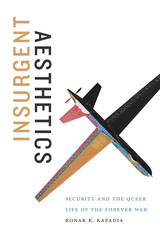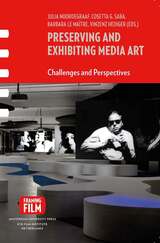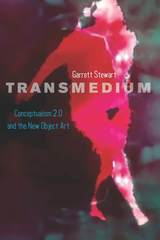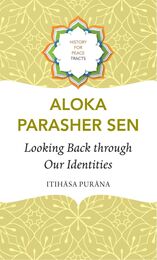4 books about Multimedia (Art)

Grime, Glitter, and Glass
The Body and the Sonic in Contemporary Black Art
Nikki A. Greene
Duke University Press, 2024
In Grime, Glitter, and Glass, Nikki A. Greene examines how contemporary Black visual artists use sonic elements to refigure the formal and philosophical developments of Black art and culture. Focusing on the multimedia art of Renée Stout, Radcliffe Bailey, and María Magdalena Campos-Pons, Greene traces the intersection of the visual’s sonic possibilities with the Black body’s physical, representational, and metaphorical use in art. She employs her concept of “visual aesthetic musicality” to interpret Black visual art by examining the musical genres of jazz and rap, along with the often-overlooked innovations of funk and rumba, within art historiography. From Bailey’s use of multilayered surfaces of glitter, mud, and recycled materials to meditate on Sun Ra’s Afrofuturism to Stout’s life-size cast of her own body that recalls funk musician Betty Davis to Campos-Pons’s performative and sculptural references to sugar that resonate with the legacy of Celia Cruz, Greene outlines how these artists use mediums such as molded glass sculptures, viscous wet plaster, and dazzling mannequin heads to enhance the manifestations of Black identity. By foregrounding the sonic elements of their work, Greene demonstrates that these artists use sound to make themselves legible, recognizable, and audible.
[more]

Insurgent Aesthetics
Security and the Queer Life of the Forever War
Ronak K. Kapadia
Duke University Press, 2019
In Insurgent Aesthetics Ronak K. Kapadia theorizes the world-making power of contemporary art responses to US militarism in the Greater Middle East. He traces how new forms of remote killing, torture, confinement, and surveillance have created a distinctive post-9/11 infrastructure of racialized state violence. Linking these new forms of violence to the history of American imperialism and conquest, Kapadia shows how Arab, Muslim, and South Asian diasporic multimedia artists force a reckoning with the US war on terror's violent destruction and its impacts on immigrant and refugee communities. Drawing on an eclectic range of visual, installation, and performance works, Kapadia reveals queer feminist decolonial critiques of the US security state that visualize subjugated histories of US militarism and make palpable what he terms “the sensorial life of empire.” In this way, these artists forge new aesthetic and social alliances that sustain critical opposition to the global war machine and create alternative ways of knowing and feeling beyond the forever war.
[more]

Preserving and Exhibiting Media Art
Challenges and Perspectives
Edited by Julia Noordegraaf, Cosetta Saba, Barbara Le Maitre, and Vinzenz Hediger
Amsterdam University Press, 2013
This important and first-of-its-kind collection addresses the emerging challenges in the field of media art preservation and exhibition, providing an outline for the training of professionals in this field. Since the emergence of time-based media such as film, video and digital technology, artists have used them to experiment with their potential. The resulting artworks, with their basis in rapidly developing technologies that cross over into other domains such as broadcasting and social media, have challenged the traditional infrastructures for the collection, preservation and exhibition of art. Addressing these challenges, the authors provide a historical and theoretical survey of the field, and introduce students to the challenges and difficulties of preserving and exhibiting media art through a series of first-hand case studies. Situated at the threshold between archival practices and film and media theory, it also makes a strong contribution to the growing literature on archive theory and archival practices.
[more]

Transmedium
Conceptualism 2.0 and the New Object Art
Garrett Stewart
University of Chicago Press, 2018
If you attend a contemporary art exhibition today, you’re unlikely to see much traditional painting or sculpture. Indeed, artists today are preoccupied with what happens when you leave behind assumptions about particular media—such as painting, or woodcuts—and instead focus on collisions between them, and the new forms and ideas that those collisions generate.
Garrett Stewart in Transmedium dubs this new approach Conceptualism 2.0, an allusion in part to the computer images that are so often addressed by these works. A successor to 1960s Conceptualism, which posited that a material medium was unnecessary to the making of art, Conceptualism 2.0 features artworks that are transmedial, that place the aesthetic experience itself deliberately at the boundary between often incommensurable media. The result, Stewart shows, is art whose forced convergences break open new possibilities that are wholly surprising, intellectually enlightening, and often uncanny.
Garrett Stewart in Transmedium dubs this new approach Conceptualism 2.0, an allusion in part to the computer images that are so often addressed by these works. A successor to 1960s Conceptualism, which posited that a material medium was unnecessary to the making of art, Conceptualism 2.0 features artworks that are transmedial, that place the aesthetic experience itself deliberately at the boundary between often incommensurable media. The result, Stewart shows, is art whose forced convergences break open new possibilities that are wholly surprising, intellectually enlightening, and often uncanny.
[more]
READERS
Browse our collection.
PUBLISHERS
See BiblioVault's publisher services.
STUDENT SERVICES
Files for college accessibility offices.
UChicago Accessibility Resources
home | accessibility | search | about | contact us
BiblioVault ® 2001 - 2025
The University of Chicago Press









